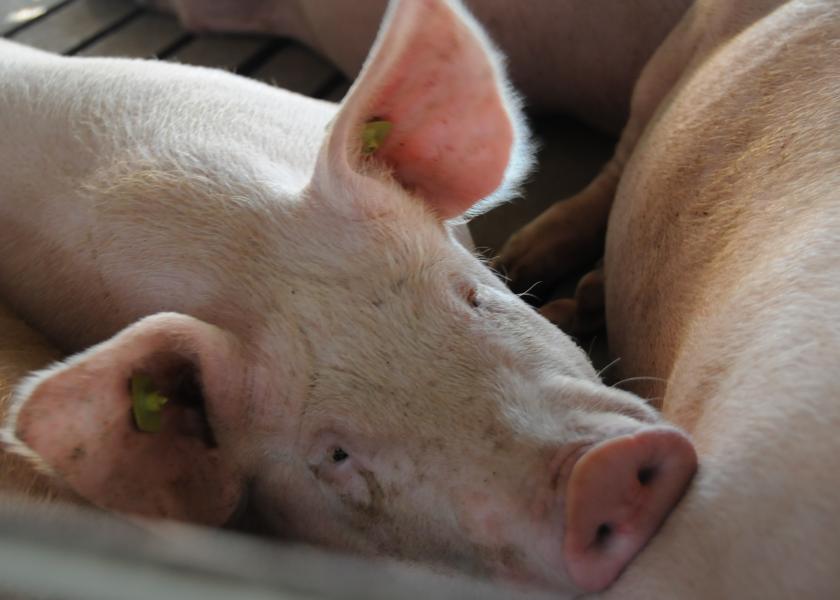Tracheal Sampling for M. Hyo May Hold New Benefits

Tracheal sampling is a good way to determine if Mycoplasma hyopneumoniae (M. hyo) is present in a herd, but it’s an invasive procedure that can be difficult to accomplish. The procedure, however, may offer a valuable benefit, said Brandi Burton, DVM, swine veterinarian with Suidae Health and Production. The fluid from the tracheal sampling could become an alternative to the lung homogenate that has typically been used for animal inoculation in M. hyo control, she told Pig Health Today.
Burton’s idea was to look at the tracheal fluid collected during diagnostic testing and use it in a solution to inoculate pigs. In theory, she didn’t see any reason why it couldn’t be used, but that theory needed to be proved.
“Right now, the gold standard is to use lung homogenate [as an inoculate] for M. hyo,” Burton said, but that can be costly from an animal-welfare and genetics standpoint. She was looking for an alternative method.
“I’ve had quite a bit of experience with tracheal sampling, so we basically diluted [the trachea fluid] and created an inoculum,” she said. “We intratracheally administered 8 mls of the solution to 30 gilts and tested them 16 days later.”
The gilts were 100% positive for M. hyo, using a polymerase chain reaction (PCR) test.
Testing the spread
Twenty-six days after the initial inoculation, Burton tested the theory a step further. The way the barn was set up, researchers tested contact and non-contact animals. They inoculated half the gilts in four pens and left the other half non-inoculated. These were the direct-contact animals. Two additional pens had fence-to-fence contact with the inoculated animals, and animals across the aisle were considered non-contact sentinels.
Results of the trial showed:
- 100% of the direct-contact animals in the pens with the inoculated gilts were positive.
- 80% of the animals with fence-to-fence contact were positive.
- 100% of the animals across the aisle from the inoculated gilts were positive.
“We feel relatively successful in that we took those 30 gilts and essentially had 100% positivity within 26 days in a group of 158,” Burton said.
Next steps
Burton said the next step is to determine the infectious dose needed to effectively inoculate the animals. Also, since many veterinarians like to use fogging as an exposure technique, Burton would like to try that protocol.
Additionally, she will look at the seeder ratio. Having 30 gilts inoculate 158 animals is “abnormal,” she said.
“That’s about a 4:1 ratio, and so it’s atypical of M. Hyo,” Burton said. “We want to look further into nailing down the seeder ratio.”
Going forward, Burton hopes to add ELISA and serum testing to the PCR tests for a fuller understanding of the M. hyo inoculant in the herd.
Burton encouraged veterinarians to keep an open mind in thinking about exposure processes for M. hyo.
“It’s definitely a benefit if we don’t have to euthanize animals to collect that lung homogenate,” she said. “Plus, a lot of farms are already doing tracheal samplings…to diagnose the farm. You can just take that sample and…use it again as an inoculum, potentially.”
Best practices
Producers need to understand their production flows when thinking about M. hyo control, Burton said. The financial consequences of M. hyo are seen primarily in grow-finish animals, so it’s important to understand the status of those pigs downstream.
“We know M. hyo doesn’t generally transmit laterally, so it’s almost always coming from the sow farm,” Burton said. She suggested monitoring for the disease with cross-sectional studies.
“Look at five to six different age groups on 1 day and do tracheal sampling along with serum and oral-fluid collections,” Burton said. “You can get a good timeline and see multiple age groups at the same time to…determine their status. Doing that at least twice a year is a good way to keep surveillance [current] and modify protocols as needed.”
Timing is important too. Burton suggested producers and veterinarians find medications that can control clinical signs early on and determine through the flow when those medications should be administered.
“You don’t want to be too far behind the ball, but you also don’t want to be too far in front of it,” she said. “You want to be right on top of it before it can become a bigger issue than it needs to be.”
The farm on which the original study was done is considering an elimination program for M. hyo, Burton said. She wants to employ the tracheal inoculation program with herd closure to see if time-to-negative-production can be shortened and to determine the minimum dosage needed as well as the dilution ratio.
Although there is a negative stigma associated with tracheal sampling because of its invasive nature, the ability to use the fluid in a way that may have long-term benefits could make the effort that much more indispensable.
More from Farm Journal's PORK:
Fogging Helps Establish Day 0 for M. Hyo Elimination
Eliminating M. hyo in Your Swine Herd: Is Fogging an Option?







